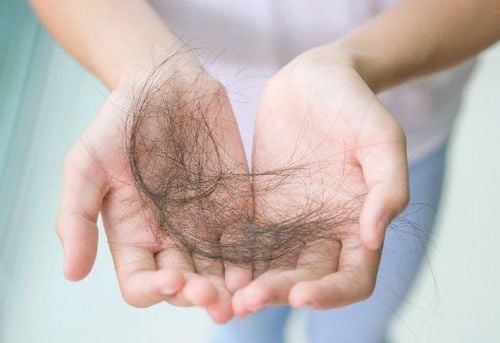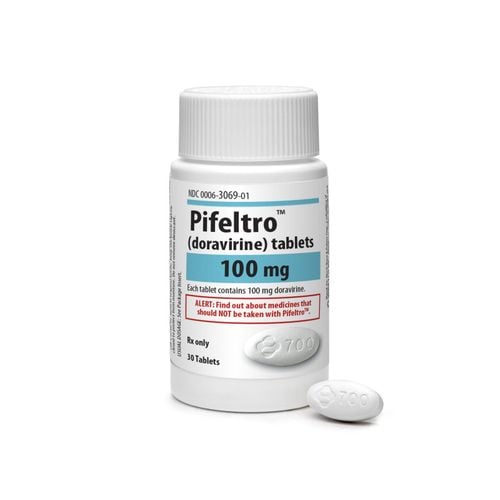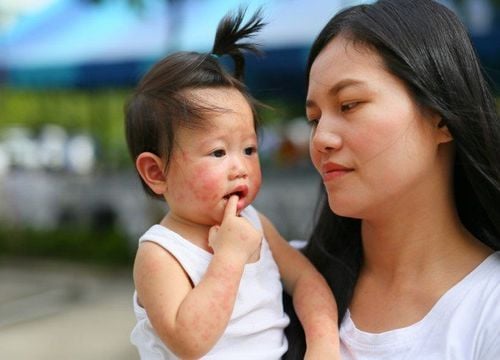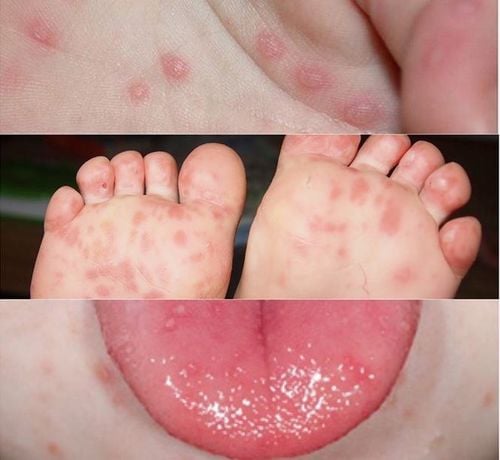This is an automatically translated article.
Hand, foot and mouth disease is a fairly common infectious disease in young children, but so far there is no vaccine to prevent the disease. Children with hand, foot and mouth disease often present with fever along with some typical symptoms such as skin rashes and mouth ulcers. So what are the characteristics of hand, foot and mouth fever and how many days does it usually last?
1. What is hand foot mouth?
Hand, foot and mouth disease is a common infectious disease in young children, characterized by a blister-like rash on the palms, soles and mouth ulcers. The causative agent is enteroviruses, of which the most common are Coxsackie virus A16 and Enterovirus 71 (EV71). EV71, although a less common cause, carries a greater risk of serious hand, foot and mouth complications. The virus that causes hand, foot and mouth disease is capable of spreading quickly and easily, can be transmitted directly from person to person through nose and mouth secretions or by direct contact with feces, saliva or secretions from blisters. of sick children. In the stages of hand, foot and mouth disease, the incubation period is considered the most ideal for the virus to spread through the following common routes:
Direct contact with infected children; Holding toys and objects of sick children; Contact with nasal secretions, fluid from blisters or feces of an infected child.
2. Stages of hand, foot and mouth
The virus that causes hand, foot and mouth disease is very contagious and has a high risk of causing an outbreak if not well controlled. Therefore, one of the measures to control this disease is to detect early signs of hand, foot and mouth disease to prevent, treat and isolate to avoid spreading. Because it is an infectious disease, most children with the disease have symptoms of hand, foot and mouth fever, besides there are other typical signs depending on the stage of the disease, specifically as follows:
Incubation stage: Lasting 3-6 days from exposure to the virus, this period usually does not show any symptoms; The onset stage: Lasts about 1-2, children with hand, foot and mouth disease begin to have the following symptoms: Hand-foot-and-mouth fever with fatigue, children may have a mild fever of 37.5-38 degrees Celsius or some children have hands and feet. mouth fever up to 39-40 degrees Celsius; Burning sensation in the gums and in the oral cavity; Some children experience symptoms of sore throat, increased salivation, sometimes accompanied by diarrhea; Full-blown stage: Lasts about 3-10 days with typical manifestations of hand, foot and mouth such as: A blister-like rash in quite specific locations such as soles, palms, buttocks, knees, buttocks ... Water burns are about 2-10mm in diameter, oval in shape, can protrude or hide under the skin, causing no pain or itching; Mouth ulcers: The mucous membranes of the cheeks, gums, and tongue of children with hand, foot and mouth blisters appear 2-3mm in diameter, which are very fragile, forming mouth sores and causing pain to the child, especially when eating; Body as a whole: confusion, startling, convulsion or delirium...; Remission phase: Usually occurs on the 7th day from the full-blown stage, the child's fever decreases or the fever completely disappears, the general condition improves, the baby is healthy and recovers if no dangerous complications occur. Hand, foot and mouth fever usually lasts for how many days, the duration of hand, foot and mouth fever usually lasts about 7 days (ranges from 4-12 days). However, we should note that not all cases of hand, foot and mouth go through the stages with the above symptoms, some children only appear mouth ulcers (easy to confuse with benign oral ulcers). common), some children develop very few blisters, alternating with erythematous nodules and even in some cases a rash without blisters.
3. Characteristics of hand, foot and mouth fever
Most cases of hand, foot and mouth are usually mild, symptoms of hand, foot and mouth fever only last for a few days, besides other symptoms are also relatively mild.
However, when a child has a high fever over 39 degrees Celsius, a prolonged fever accompanied by a few symptoms of complications such as startling sleep, convulsions, difficulty breathing... then parents need to take the baby quickly. to the hospital.
Currently, in the world, there is still no specific medicine to treat hand, foot and mouth. Current treatment methods are mainly symptomatic treatment, support to support the body and treat complications if any. Therefore, parents need to know the signs of severe hand, foot and mouth disease to quickly bring the child to a medical facility in time when needed.
Warning symptoms of hand, foot and mouth disease include:
Children with hand, foot and mouth disease that are persistently high fever do not respond to antipyretic drugs: Although most children have symptoms of hand, foot and mouth fever, it is usually mild and responds to hypothermia, so a high fever may suggest another problem, possibly fever from complications of hand, foot, and mouth disease; Startled when sleeping or even when the child is playing; Children are very tired, do not play, sleep a lot, their perception changes to lethargy or drowsiness; Sweating, coldness all over the body or localized to the hands and feet; Rapid breathing or unusual breathing patterns such as apnea, shallow breathing, chest indrawing or wheezing; Tremors or body tremors, unsteady gait or unsteady sitting.
4. Hand, foot and mouth care and treatment
Most cases of hand, foot and mouth are mild, children usually have no fever, no further rash and recover completely within 7-10 days, except for cases with dangerous complications.
Children with mild hand, foot and mouth disease can be treated and cared for at home by a doctor, and periodically re-examined by appointment to detect complications in time.
Because there is no specific medicine, proper care of the child will support the faster and more effective recovery process, while minimizing the risk of dangerous complications. During the care process, parents need to pay special attention to the following 4 issues:
4.1. Isolate children properly Hand, foot and mouth is very contagious in crowded places such as kindergartens, schools or public places. Therefore, as soon as a child is diagnosed with hand, foot and mouth disease, they must be isolated from healthy children and family members. Parents should not send their children to school for a period of 10-14 days from the date of illness, and at the same time notify the school for appropriate handling measures and avoid infecting classmates.
4.2. Proper nutrition Hand-foot-and-mouth fever and other symptoms such as mouth ulcers often make children anorexic, because eating will be painful and uncomfortable. Therefore, parents should prepare soft, easy-to-swallow and easy-to-digest foods for their children to help them eat more. The diet needs to ensure enough groups of substances, both supplementing the essential nutrients for the body to function and supporting the faster recovery process.
Parents need to limit giving their children too hard pacifiers or eating with sharp-edged tools, and at the same time do not give their children too hot or spicy foods because this can lead to more serious mouth ulcers. Children with high fever should be given extra attention to replenish water to limit the risk of dehydration.
4.3. Maintain hygiene Careful hygiene for sick children and caregivers will limit the spread of the virus to a large area, and support faster treatment and recovery.
Children must have good personal hygiene and must not limit bathing when they have hand, foot and mouth disease. However, because the body is weakening, parents need to let their children bathe in a well-ventilated room with antibacterial soap.
Personal items such as bottles, eating utensils, living utensils, toys for sick children need to be separated and cleaned regularly to disinfect. Clothes and diapers for sick children need to be changed regularly, then treated by soaking with specialized antiseptic solutions.
4.4. Hand, foot and mouth disease is a disease caused by a virus, so parents should not arbitrarily give their children medicines without a doctor's prescription, especially antibiotics. This drug has no effect on the virus and in fact does not bring about any effect. In case the child has a high fever, you can take fever-reducing medicine (Paracetamol) with an appropriate dose or other drugs prescribed by the doctor.
Please dial HOTLINE for more information or register for an appointment HERE. Download MyVinmec app to make appointments faster and to manage your bookings easily.













